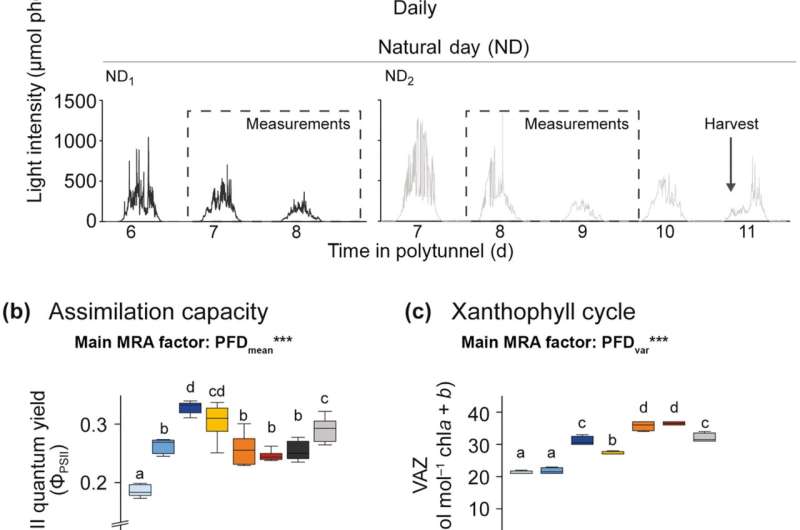Between light and darkness: How plants optimize photosynthesis under changing light conditions

For research, plants are frequently grown under stable lighting, which does not reflect natural conditions. In a series of experiments with changing light conditions, simulating the natural interplay of light and shadow, researchers from the Max Planck Institute of Molecular Plant Physiology in Potsdam-Golm (Germany) and the College of Natural Science at Michigan State University (U.S.) reveal the importance of two key proteins for the dynamic control of photosynthesis. The study was recently published in the journal New Phytologist.
Plants perform photosynthesis to grow. In this process they use energy from sunlight, release oxygen, and produce carbohydrates, which are the basic food resource for all humans and almost all animals on earth. Under natural conditions, light availability can change rapidly in a very short time.
One of the main reasons are clouds which provide light and shadow as they pass in front of the sun. Plant leaves and branches can also temporarily provide shade when they are moved by the wind. Plants cannot move from shade to sun when light is limited, and conversely, cannot evade from sun to shade when exposed to too much sunlight. They have to respond to changing light conditions in other ways.
Just like for humans, too much sunlight is harmful to plants. In particular, a rapid change between faint and intense light is problematic. Like the retina in our eyes, plants use molecules in their leaves to capture light particles. When light is low, these light traps are very efficient at catching as much of the low light as possible.
If light conditions suddenly change, too much light energy might reach the plant. This energy can overload or damage the sensitive photosynthetic apparatus inside the plant cells. Accordingly, plants have to constantly adapt their photosynthetic activity to their environmental conditions in order to obtain maximum light yield on the one hand, but avoid being harmed by too much light on the other hand.
To date, plants in greenhouses and laboratories are grown almost exclusively under stable and uniform light conditions. Therefore, our understanding of how adaptation to changing light conditions works is very limited. In the worst case, this can lead to plants that are growing well in laboratories and greenhouses but suddenly perform much worse than expected when cultured in the field.
Regulation of photosynthesis under changing light conditions
The researchers around Dr. Ute Armbruster from the MPI-MP in Potsdam-Golm and David Kramer from the College of Natural Science at Michigan State University (U.S.) examined the model plant Arabidopsis thaliana for their study. Plants were grown under a wide variety of conditions including static, fluctuating and natural light.
The study focused on two ion transport proteins called VCCN1 and KEA3 which play a key role in dynamically adjusting photosynthetic performance. It is known from earlier studies that VCCN1 activates sun protection if the light suddenly becomes too strong. When the light intensity decreases, the second protein KEA3 quickly breaks down this sun protection so that the plant can catch more light again. However, the two proteins VCCN1 and KEA3 have never been examined under realistic light conditions.
The researchers used an innovative new approach to measure photosynthesis in combination with a targeted use of gene knockouts—i.e. plants whose genes for VCCN1 and KEA3 have been switched off. They show that the activities of the proteins VCCN1 and KEA3 depend on the light conditions the plants were raised in.
Following suggestions by the head of the Plant Cultivation Infrastructure Group, Dr. Karin Köhl, the researchers focused on two growth-related light factors in the analysis and were able to show that both the amount of light a plant receives, and the frequency of light fluctuations have a strong influence on the function of the two ion transporters. The protective function of VCCN1 is only important in plants previously grown under low light.
On the other hand, KEA3 which abolishes protection, was even active in high light periods when the plants were grown under conditions with elevated light intensities. Sun protection also depends on the degree of light fluctuations the plants are exposed to. When light conditions change significantly, plants produce the orange pigment zeaxanthin, which is also involved in sun protection. The production of this sunscreen is suppressed by KEA3 under high light conditions as well.
“Our study shows that we should not look separately at the effect of growth light and the rapid responses to light fluctuations,” said study lead author Thekla von Bismarck. “The integration of multiple time scales and metabolic levels in an increasingly complex manner will be a major future challenge for crop research. This will provide key ideas to improve crop yields in the field.”
More information:
Thekla von Bismarck et al, Light acclimation interacts with thylakoid ion transport to govern the dynamics of photosynthesis in Arabidopsis, New Phytologist (2022). DOI: 10.1111/nph.18534
Provided by
Max-Planck-Institut für Molekulare Pflanzenphysiologie
Citation:
Between light and darkness: How plants optimize photosynthesis under changing light conditions (2022, November 16)
retrieved 17 November 2022
from https://phys.org/news/2022-11-darkness-optimize-photosynthesis-conditions.html
This document is subject to copyright. Apart from any fair dealing for the purpose of private study or research, no
part may be reproduced without the written permission. The content is provided for information purposes only.
For all the latest Science News Click Here
For the latest news and updates, follow us on Google News.

